Experimenting with the Flipped Classroom
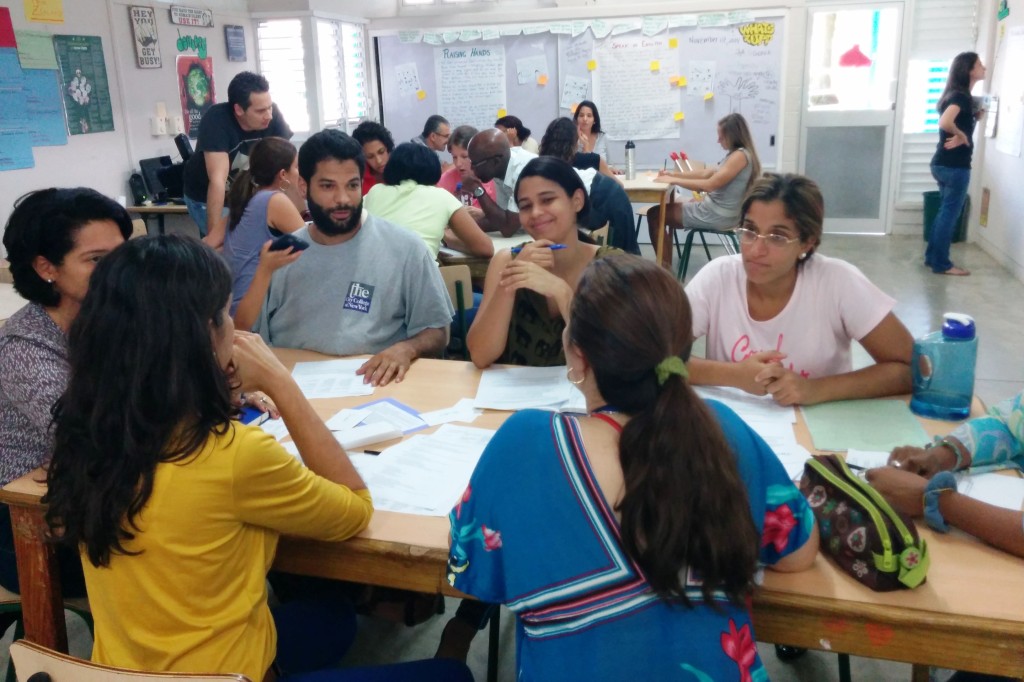 Flipped classroom ideas are everywhere on the internet lately and they make so much sense. Instead of lecturing in school and having kids work at home, the flipped classroom has kids read theory and listen to lectures at home, then do the work in class, where they are supported by a teacher and other students. In school, students can ask questions, receive guidance, and the actual work gets done with teacher support.
Flipped classroom ideas are everywhere on the internet lately and they make so much sense. Instead of lecturing in school and having kids work at home, the flipped classroom has kids read theory and listen to lectures at home, then do the work in class, where they are supported by a teacher and other students. In school, students can ask questions, receive guidance, and the actual work gets done with teacher support.
I’ve been dying to try these methods at school. There’s a problem though: I no longer teach, so I don’t have a classroom where I can try out new ideas. I hate asking teachers to implement technique I’ve never done before – “Sure, sure, go ahead, it’ll be easy. Things to watch out for? Hmmm… I really have no idea. The guy in the video made it look easy though…” – before asking them to implement a new technique, I want to make sure I’ve tried it myself so that I’ve encountered the pitfalls and ironed out some of the glitches.
I decided to start my experiment in October. The beginning-of-the-year honeymoon period was over and teachers were beginning to face problems with their students – kids whining about homework, talking incessantly, fooling around in class, and sometimes talking back to teachers. It was time for some professional development workshops on classroom management.
And here was my chance to try out the flipped classroom idea I’d been looking into. Trying new ideas in front of an audience is always a little nerve-wracking, and doing it in front of a group of excellent teachers is even scarier. But I preach “taking risks” and had to walk the talk. So I got to work.
I wanted to share ideas from Rick Smith’s wonderful book, Conscious Classroom Management. In many flipped classrooms, teachers videotape themselves giving a lecture, but I was not at all ready for that. Instead, I prepared a PowerPoint presentation that shared Smith’s ideas, interspersed with reflections and videos of teachers in action. I sent that off to the teachers to read for “homework,” then prepared four centers for them to work on in the classroom. The centers were varied – role play, brainstorming ideas on a chart, letter writing, and a sorting activity. I thought they would be an engaging, “fun” way to learn the material we were covering.
The activities went pretty well in our first flipped workshop. Teachers were engaged, discussing ideas, laughing, and sharing experiences. l didn’t see any of the usual Friday afternoon hidden yawns or furtive glances at the clock. On the negative side, I realized that 4 centers was too many but didn’t know how to get around that (there was so much information to cover!) so I chose to ignore this problem. Overall, I was feeling happy as I prepared the second flipped lesson. However, I was overly confident which led me to make two big mistakes: I got lazy and didn’t put as much time into making creative centers. I also decided to continue with four centers, even though I knew that this was too many. Needless to say, my second workshop didn’t go as smoothly.
In preparing the third class I learned my lesson. I took a little more time to reflect on what went wrong and decided to make some important changes in the next workshop. At this point I had covered Rick Smith’s ideas about taking preventative measures in the classroom and now we would be looking into what to do when students continue misbehaving in spite of everything we’ve done to help them. So I wrote my presentation up from my own experience using the discipline system we follow at school, which is built on the program presented in Discipline Without Stress by Marvin Marshall. And,finally learning from experience, I worked hard to come up with creative ideas for my centers and I decided to make THREE of them.
At the end of the workshop teachers gave feedback so that we could all learn how to do a better job of flipping our classrooms. Here’s what we learned from my flipped classroom experiment:
- Doing four centers was too hard. Three was much better. Definitely. When preparing activities for students, make sure there’s enough time to do the activities and to reflect on them at the end.
- The third PowerPoint flowed better – it was easier to read. Ah, I wasn’t aware of that. The first two were a summary of someone else’s ideas, while the third one flowed naturally from my own experience. I guess the lesson here is to be authentic and use your own voice. Along this line, I imagine that videotaping myself talking would be better than a PowerPoint presentation – which is quite scary for me, but I intend to try it.
- Including videos in the third PowerPoint would have helped. I searched for videos that showed the Discipline Without Stress technique in action, but I couldn’t find any, so I decided not to include videos. But this a weak excuse… I could have used some videos of behavior techniques that we don’t agree with and asked teachers to reflect on why they don’t model our philosophy. Or I could have filmed some of our teachers in action. At the very least, I should have included some pictures. Visuals are important.
- The second set of centers was not as well thought out. I agree. I noticed it right away in the PD session. The energy was lacking and teachers were getting bored. The centers were too similar and they didn’t work as well. When preparing activities, be creative; make sure they’re all different.
- I was tired and had a headache when we started, but it was so engaging that I completely forgot about my headache and didn’t notice time passing. It works!! Discussing, brainstorming, role playing, and reflecting are so much more interesting than listening to a teacher lecture. And I got to actively teach. As I moved around from group to group, I listened to ideas, answered questions, and nudged teachers’ thinking.
One of the important questions that came up: What if kids don’t read the theory or listen to the lecture at home? This is obviously a huge damper, but think about it….in a traditional lesson do all kids pay attention to the teacher? Even when we lecture in class, we know that several students are zoning out. Nothing really changes – we still have to find a way to teach those kids. But with less time spent lecturing and more time spent working with students, it seems to me we’ll have a better chance of reaching all our kids.
I still have a lot of learning to do… but even with its imperfections, everyone agreed that the flipped classroom was much more engaging than my usual lecture/activity format.

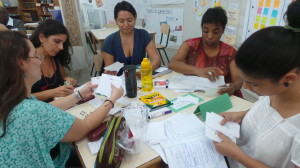
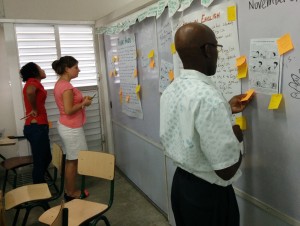
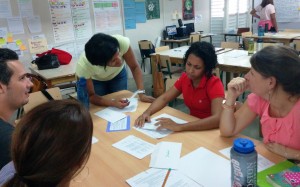
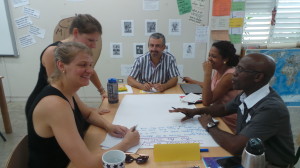
Leave a comment